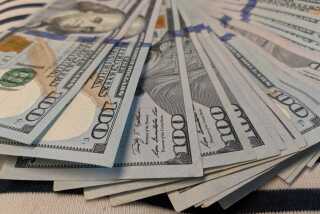Dollar Gains Strength--at Least Until the Euro Arrives
- Share via
If you’ve lost track of how the dollar has been doing against European currencies lately, you’re excused. Through winter and spring, the financial world has been focused on Asian economic crises and the opportunities they have afforded canny foreigners with dollars. Meanwhile, most of Europe has quietly moved along, neither as troubled as Asian nor as boom-giddy as the U.S.
But there’s ample reason to pay attention, all the same. Travel agents and tour operators report another summer of record travel by Americans to Europe is in the offing; Americans probably will log more than 10 million transatlantic trips in 1998.
The short-term good news for those travelers is that in the last year, exchange figures suggest that Americans have gained buying power throughout Western Europe, especially in Greece and Ireland, but also in Germany, France and other frequent vacation destinations. Only in England did the dollar lose strength. Over the 12 months ending April 21, 1998, the dollar gained about 4% against the E.C.U. (European Currency Unit), a broad measure that weighs a “basket” of 12 European nations together.
In the longer term--but only a slightly longer term--the big issue is the long-promised convergence of European currencies, an issue that remains hazy to many Americans. The ultimate goal is a simpler, cheaper life for European businesses, a development that will ease life for the American traveler too. But the next four years, during which economists aim to boil 11 currencies down into one, will be full of big changes. To make sense of it all, it’s important to start paying attention now.
First, exchange rates. Inter-bank trading figures show the dollar had gained more than 14% against the Greek drachma in the 12 months ending April 21. Over the same time frame, the dollar gained more than 10% against the Irish punt, and 6.5% against the Portuguese escudo. The dollar’s gains against the German mark, French franc, Spanish peseta, Italian lire, Austrian shilling, Belgian franc and Dutch guilder all fell between 3% and 5%. Advances against the Swedish krona and Swiss franc were smaller. The dollar lost 2.8% against the British pound.
The numbers are generally encouraging, but consumers shouldn’t read too much into them for a couple of reasons.
One: Remember that the numbers above are based on inter-bank trading rates, the numbers used by institutions trading $1 million or more. The retail rates that banks and exchange houses charge individual consumers (such as the Thomas Cook figures reprinted weekly in this section) vary widely, but are generally 1%-10% more costly than inter-bank rates.)
Two: Exchange rates alone don’t necessarily give a fair picture of one currency’s buying power in another country. Most notably, if one country’s internal inflation rate is 5% and another’s is 25%, then looking only at their exchange rates is an apples-and-oranges comparison. (Inflation has, however, been relatively low everywhere in North America and Europe lately. European Commission estimates put Western Europe’s 1997 inflation rate at 1.6% (with Greece inflating fastest at 5.2%). The U.S. rate for 1997 was 2%.
Meanwhile, here comes the euro: Since 1992, the political leaders of Western Europe have been edging toward monetary unity. Once the new system is in place, a little over four years from now, even a whirlwind visit to many countries will mean handling just one currency, the euro.
Which countries are going euro? The official decision on that is due in early May from the 15 heads of state in the European Union. But European Commission officials and European Monetary Institute officials in late March disclosed the 11 likely euro nations: Austria, Belgium, Finland, France, Germany, Holland, Ireland, Italy, Luxembourg, Spain and Portugal.
Britain, Denmark and Sweden have chosen not to join, and Greece so far does not meet euro technical requirements.
In January 1999, the E.C.U. will give way to the euro, participating nations will agree on rates at which their currencies will lock in with each other, and governments will use the euro in their book-keeping as a step toward the broad introduction of the new currency by January 2002.
“As a U.S. tourist, you’re not going to be losing money changing marks to francs. So you’re going to be saving money in that sense,” notes European Commission spokesman Chris Matthews. “And if you’re dealing with electronic transactions, like credit cards, the deal will be in euros.”
Barring a major lurch in valuations, a euro probably will be worth about $1.08, and like the dollar, it will be made up of 100 cents. Current plans call for coins (to reach circulation in 2002) valued at one, two, five, 10, 20 and 50 cents, as well as a 1-euro coin and a 2-euro coin. (By one estimate, the European public and private sectors will spend $29 billion dollars to make the currency transition.)
For a while, the euro will coexist with marks and francs and guilders and lire and all the rest. But if all goes according to schedule, by July of 2002 those old currencies will no longer be legal tender.
For more information on Europe, readers can write or call to receive the European Travel Commission’s 66-page free publication, “Planning Your Trip to Europe, 1998.” (European Travel Commission, Department A, P.O. Box 1754, New York, NY 10185; tel. [800] 816-7544.)
Reynolds travels anonymously at the newspaper’s expense, accepting no special discounts or subsidized trips. He welcomes comments and suggestions, but cannot respond individually to letters and calls. Write Travel Insider, Los Angeles Times, Times Mirror Square, Los Angeles 90053 or e-mail chris.reynolds@latimes.com.
More to Read
Inside the business of entertainment
The Wide Shot brings you news, analysis and insights on everything from streaming wars to production — and what it all means for the future.
You may occasionally receive promotional content from the Los Angeles Times.











